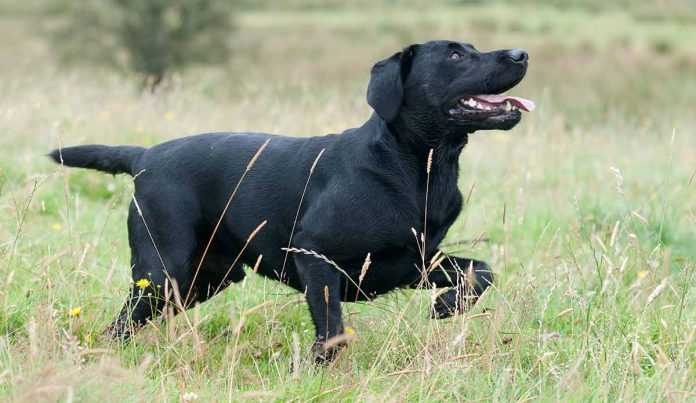The Lab Pointer mix is a hybrid designer dog combining the Labrador Retriever and Pointer breeds. Your Lab Pointer mix puppy can have an English Pointer, German Shorthaired Pointer or German Wirehaired pointer parent. They are a great pet dog, if matched with the right home. This active mix enjoys being part of a family and are good with kids over five. Smaller children may get knocked over by large and boisterous gun dog puppies, but young members of the family will enjoy having a furry playmate who’s always ready to be part of a game. Pointer Lab mixes are sturdy dogs that are soft at heart and love to please their families.
Contents
- Sporting dog backgrounds
- Variations between Pointer types
- Appearances and temperament traits
- Lab Pointer mix puppies
Thanks to their spirited nature, Lab Pointer mix dogs need a lot of exercise, and space. A big back yard is best – somewhere fenced in where they can run and explore. Alert and intelligent, the gun dog breeds and breed mixes are usually a joy to train.
Lab Pointer Mix – A Sporting Dog
Both Labradors and Pointers are hunting dogs. Part of the sporting dog group, and many serve dual roles as working companions and family pets. But while these are dogs that have some traits in common, they also have very different roles to play and this has affected their temperament and behavior
There are four different types of gun dog
- Pointers and setters
- Retrievers
- Spaniels
- HPRs
Pointers are an ancient breed and were bred to ‘point’ at game. You’ll have seen old paintings with pointers or setters ‘on point’.
It’s a classically beautiful pose, with one front paw raised. Often with a second dog backing the first in an identical position.
Setters and Pointers perform the same function and were very popular before breech loading guns were invented.
They gave the hunter a chance to load their weapon and get close enough to the game to take a shot, before the bird was flushed.
These dogs were bred to gallop over huge areas of moorland and open countryside, searching for tiny traces of scent in areas where game birds are few and far between.
This required a big powerful deep chested dog capable of quartering large areas independently, with a hunter following – on foot or on horseback
These are the true Pointers – sometimes called English Pointers. And it’s important that you understand their purpose if you are thinking of buying a puppy with a Pointer parent.
However, what many people mean when they talk about Pointers is a very different dog. Let’s take a closer look
Different types of pointer
There are three main types of pointer commonly kept as hunting companions, family pets, or bred for the show ring
- The Pointer
- The German Shorthaired Pointer
- The German Wirehaired Pointer
The two German pointers, the shorthaired and the wirehaired, belong to the fourth group of gun dogs listed above – the HPRs
HPR stands for Hunt, Point, and Retrieve
These are what is often known as the ‘versatile gundogs’ and have now for the most part taken over from our old breed, the true pointers, as popular hunting companions.
They are modern, multi-purpose, gun dogs capable of hunting up game, pointing at it, and retrieving it.
Much of the time, when people buy a Lab Pointer Mix they are buying a Lab crossed with a GSP. And for the most part, that is a good thing! That’s because a German Pointer is generally a more manageable dog for the average modern family than the larger, independent, wide ranging Pointer described at the beginning of this article
German Shorthaired Pointer Lab Mix
Both Labrador Retrievers and German Shorthaired Pointers are eager to please, good-natured and smart.
These breeds are both are athletic working dogs that need plenty of exercise, are very playful, and get bored quite easily
For this reason a German Shorthaired Pointer and Lab mix can be a good choice for an active household that can make plenty of time for play. And who are willing to devote time each day to training their dog.
Lab Pointer mix origins – why create a hybrid?
The origins of the Labrador Retriever have been described in some detail in Pippa’s article on the History of the Labrador.
To understand the origins of a Lab x Pointer mix, we can begin by going back a few decades.
In the late 1990s, so-called “designer dogs” hit the headlines as dog-owners and breeders sought to combine favorite breeds and create a new generation of hybrids.
The early crosses were often promoted as having the best attributes of both parents. Claims were made that Labradoodles for example would all be hypoallergenic or at least low shedding like their poodle parent.
We now know that this isn’t true.
When we cross two very different dog breeds, which attributes each puppy will get from each parent is to some extent a lottery.
The puppy could get the best attributes of both parents, or the worst.
Using two dog breeds from the same group, in this case the sporting group, does however increase the chances that the resulting puppies will be similar, because the parents have similarities too.
It is interesting to note that Lab Pointer mix origins, go back much further than the desire for designer puppies.
That’s because people in the hunting community have traditionally been happy to experiment with breed crosses that suit their purpose.
HPRs have probably long been included in the occasional Labrador breeding programme, albeit illicitly, in order to incorporate the pointing instinct into certain lines of retrievers.
Basically the Labrador Pointer crossbreed is nothing new. And has been around as a capable hunting companion and all round family pet for many years
Lab Pointer mix size
Both Labs and German Shorthaired Pointers are among the larger of the medium-sized dogs.
Their offspring typically weigh anywhere between 50 and 85lbs, with males being larger than females. And cross-bred puppies are likely to grow to a height of around 23 inches at the shoulder (a little less for females)
A Lab crossed with a true Pointer however, is likely to be a taller dog altogether. The true Pointer reaches up to 28 inches in height, and some of his cross-bred puppies may well do the same.
Labrador Pointer mix colors
There are just three coat colors for Labrador Retrievers – black, yellow and chocolate.
Pointers, on the other hand, can be found in 8 different colors. Including liver, lemon, black or orange. And in combinations of these colors with white.
They often have distinctive and beautiful markings with usually a white muzzle with dark ears and eyes.
German Pointers come in all kinds of pretty variations of the color liver (a rich dark brown) either solid or mixed with white spots or ticking.
In the UK, the GSP is also found in all those variations but with a black base color rather than liver.
The Pointer Labrador mix can have any or all of its parent’s colors, depending on which genes get handed down.
Within any hybrid litter, you can expect a lot of variation. You could have a black Lab Pointer mix, a chocolate Lab Pointer mix or a yellow Lab Pointer mix.
A German Shorthaired Pointer black Lab mix might not necessarily be black. If it favors its Pointer parent, it could be a mix of colors.
Even experienced breeders sometimes have a hard time predicting what their new Pointer Labrador pups will look like!
Labrador Pointer cross shedding
When it comes to coat length and texture things are a bit more predicable with a GSP or Pointer cross as both Labs, Pointers, and German Shorthaired Pointers have short fur.
Labs have a short, dense, weather-resistant coat that can be ‘hosed down’ and requires basic regular grooming. Labradors can be heavy shedders due to their double coat,
The GSP and Pointer coat is very short and easy to care for. Mix pups may take after either.
The German Wirehaired Pointer has a broken or rough coat which is low maintenance
A quick once over with a body brush two or three times a week, and the use of a de-shedding tool when necessary should be sufficient to cover the grooming needs of your Lab Pointer Mix pup.
Lab Pointer mix temperament
There are two sides to a Labrador x Pointer mix. The sweet-natured family pet, versus the energetic working gun dog.
These are loyal, intelligent dogs who can be independently-minded, but are very amenable to training.
They form strong bonds with their owners, so can be prone to separation anxiety.
And they do best in a stimulating environment – one that challenges them both mentally and physically.
While it might seem like this headstrong mutt needs a lot of exercise and attention, just like either of their parent breeds, they will repay you over and over with their affectionate, loving nature.
It is worth noting that the pointing breeds, which traditionally had to work much more independently and over greater distances than the retriever breeds, tend to be more independent in nature.
Labrador versus Pointer temperament
The Labrador Retriever is one of the most co-operative dog breeds on the planet. That is why they are so widely used as service and therapy dogs.
When you mix a Labrador with a German Short Haired Pointer, you are likely to lose some of this intense desire to co-operate with people, that is the hallmark of the Lab.
You may gain some pointing skills, and you may have a dog with better genetic health. But that pure Lab temperament is hard to beat from a training point of view.
When you mix a Labrador with a true Pointer, the resulting puppies can be very different indeed in temperament from a Retriever puppy
The Pointer is a more independent and less biddable dog that the Labrador. So its important to take this into account
Labrador Pointer exercise
Coming from two working breeds, Lab Pointer mixes have a lot of energy.
They love being outdoors and are ready for anything – running, swimming or hiking.
A Labrador or GSP needs at least an hour and a half walking each day. A true Pointer needs far more and many are ideally suited to being exercised on horseback.
These pups should also have an enclosed yard where they can run around and stretch their legs on a daily basis.
You’ll know if a Lab Pointer mix isn’t getting enough exercise. They can become destructive, burning off their excess energy by chewing.
If your Lab Pointer mix does damage around the house, consider that the dog may be acting out because they’re not getting the exercise they crave.
Exercise is also an important way to keep these high-spirited mutts healthy, and stop them from becoming overweight which could lead to health problems down the road.
Lab and Pointer mix health
Any puppy has the potential to inherit health problems carried by its parents.
Different breeds are often prone to different diseases, and this means that some cross bred puppies have an advantage in terms of health.
A puppy is less likely to inherit a known disease if that disease isn’t present in the breed of one parent, and far less likely to present with a new type of disease if the parent dogs are from different breeds
If the two parent breeds share a known disease then your puppy is at risk from that disease in just the same way that a purebred puppy is at risk.
When it comes to Lab Pointers, the ones to watch out for are elbow and hip dysplasia, epilepsy and progressive retinal atrophy (PRA).
Elbow and hip dysplasia is a painful condition affecting the animal’s joints which can cause lameness. It can affect both Labs and Pointers.
A 2001 study found that weight was a significant risk factor in this dogs with this condition, so it’s important to keep your Lab Pointer trim.
Labs and Pointers are also prone to the degenerative eye disorder, PRA. However, this disease, like many others can be screened for and eliminated from the gene pool.
All good breeders should be able to provide you with information on your pup’s health history and that of its parents. They should screen for diseases such as PRA as standard.
If your mutt is a German Shorthaired Pointer Lab mix, be aware that German Shorthaired Pointers can suffer from eye problems including PRA and cataracts.
They can also carry a genetic form of hemophilia known as von Willebrands Disease which prevents blood from clotting. Again, these are diseases that your breeder should screen for with every litter.
One of the advantages of buying a cross breed puppy is that the known reduced health risks are reflected in lower pet insurance premiums
Lab Pointer mix lifespan
A large health survey published by the Kennel Club in 2004 reported a median age at death for Labradors of 12 years and 3 months old
German Shorthaired pointers came in at 12 years
Pointers fared a little better at 12 years and 5 months
And studies have shown that mixed breed dogs tend to have greater longevity than most pedigree breeds
Essentially, with a little luck, adequate exercise and good nutrition, you can hope for a lifespan of around 12 years or more for your Labrador Pointer Mix
German Pointer Lab mix breeders
So you’ve decided that a Lab Pointer is the dog for you.
What next?
When looking for a breeder it’s important to do your homework.
Sadly the growing popularity of hybrid dogs has led a lot of unscrupulous dog breeders to enter the market.
A good breeder will be happy to answer all your questions, and let you look around their kennel to meet some Pointer Lab puppies.
They’ll also do the necessary health checks and have all the information about your pup’s parentage.
Pointer Labrador mix puppies
Buying from a breeder isn’t the only option when looking for your pup. It can be very rewarding to open your home, and your heart, to a rescue dog.
Breed rescues can be found in most regions and often have cross bred dogs and puppies looking for new homes. They will offer a supportive and knowledgeable adoption service.
We have provided a list of dog rescues in North America and the UK. You’ll find the links you need on those pages
With your German Shorthaired Pointer Lab mix rescue, remember that there is no certificate of parentage or health screening. This may exclude you from entering some competitions run by the AKC or KC. And from registering your puppies should you decide you want to breed from your dog
Potential owners should be aware that adopting an unknown dog always carries some risk.
Going through a reputable rescue society will help to minimize that risk, and give you and your dog the back up and support you need
The Labrador Site Founder
Pippa Mattinson is the best selling author of The Happy Puppy Handbook, the Labrador Handbook, Choosing The Perfect Puppy, and Total Recall.
She is also the founder of the Gundog Trust and the Dogsnet Online Training Program
Pippa's online training courses were launched in 2019 and you can find the latest course dates on the Dogsnet website




















